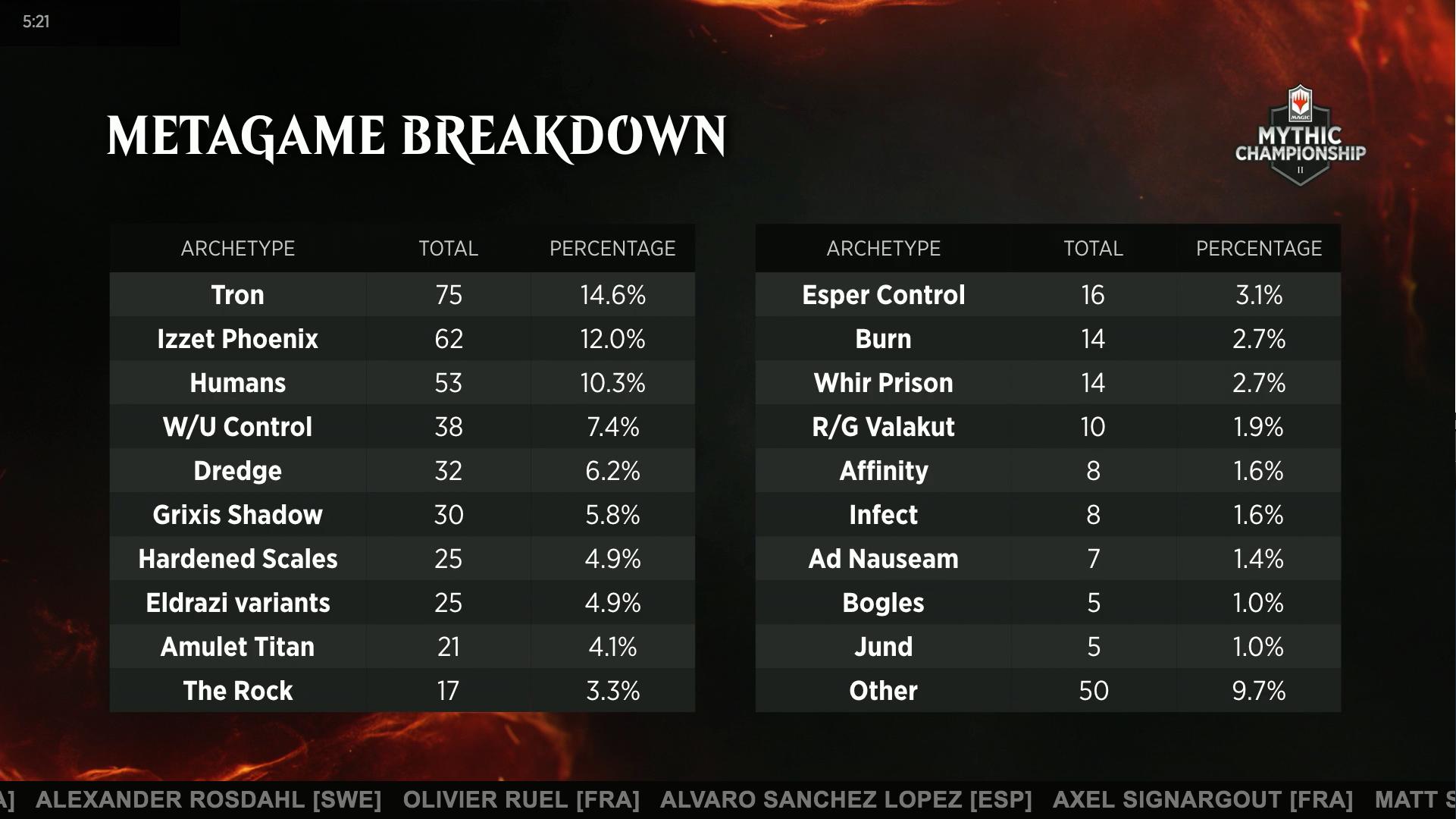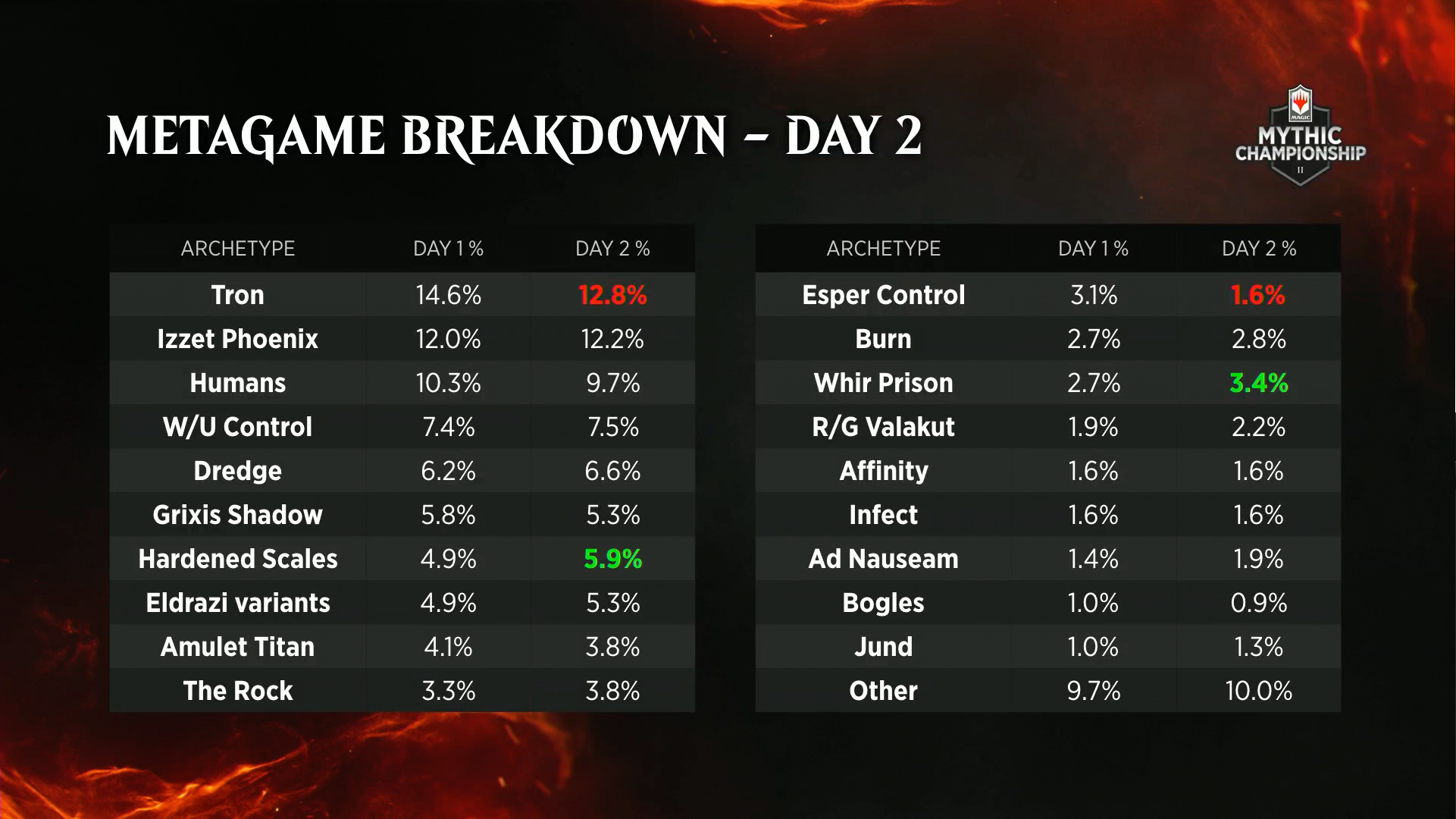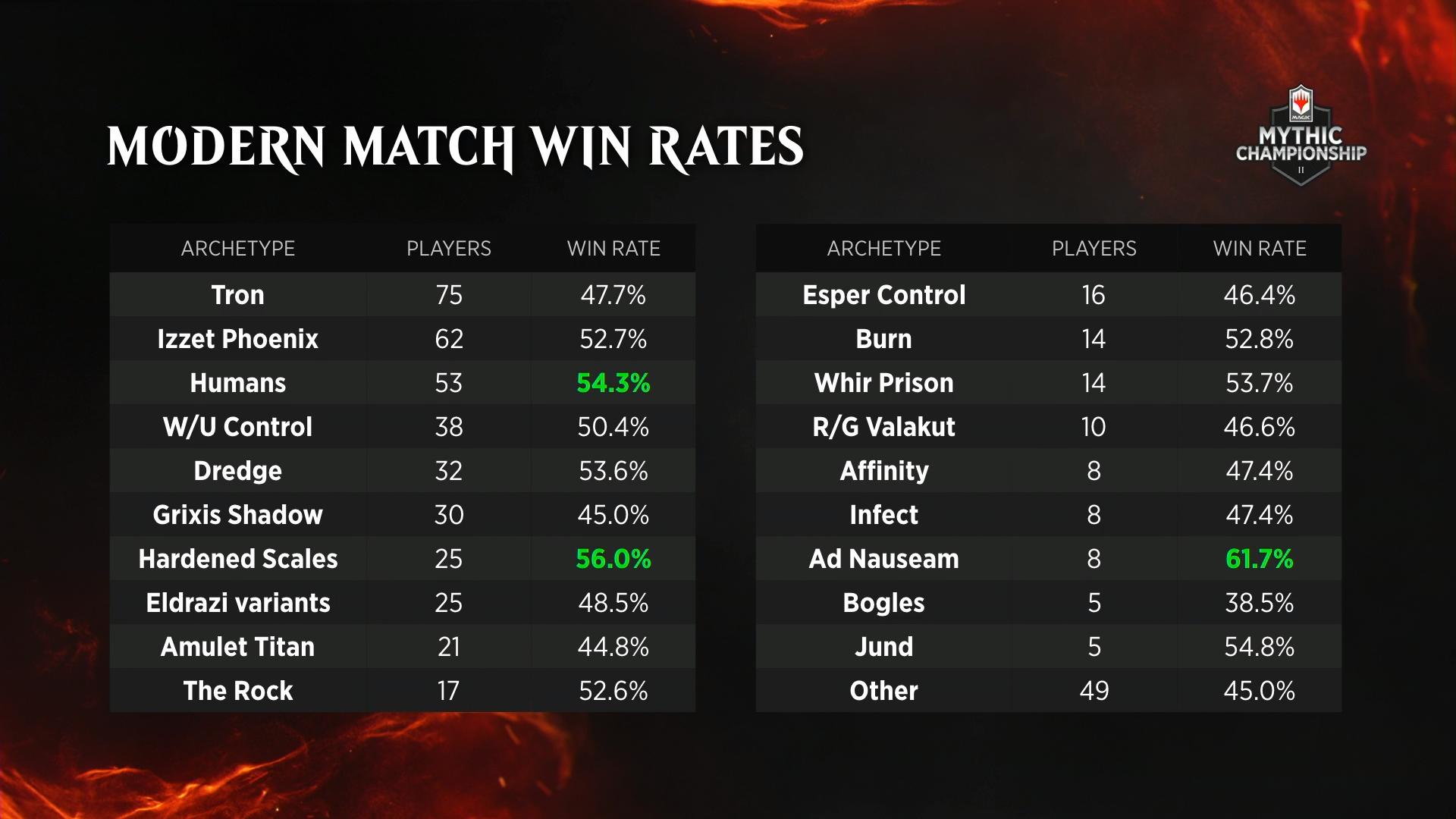What a weekend in London. Mythic Championship II is in the books, and Modern took center stage. Anticipation surrounded the event because of the London mulligan test and the debut of open decklists. Now the dust has settled on the high-profile event, what can we learn?
Let’s reflect on the tournament and see how the Modern landscape will look going forward. Although Mythic Championships tend to adopt their own metagame given the skill level of the players and the smaller field, they still presents an accurate snapshot of future Modern.
Here is the Day One metagame of the Mythic Championship:

The Day One breakdown may be surprising to some: Izzet Phoenix wasn’t the top deck! Phoenix has been dominating Modern and become the default strategy for many players, but the metagame has begun to shift, as we saw a few weeks ago. If there is one thing Tron is capable of doing, it’s policing the format.
Tron was the most represented deck on Day One, which should not be too surprising.The deck matches up well against the current Modern metagame. While everyone geared up against graveyard strategies, Tron avoids that mess with an array of huge threats. Being able to exile all sorts of permanents pays big dividends in the format; Ugin, the Spirit Dragon and Karn Liberated answer in abundance. Aggressive strategies such as Humans can struggle against the “smaller” threats such as Wurmcoil Engine and Thragtusk and their lifegain bonuses. Sweepers like Oblivion Stone can devastate all sorts of decks.
The Day Two metagame showed us little change, but the conversion rates are interesting.

It’s interesting to see how Tron was the most represented deck but had one of the lowest conversion rates. Its high representation was enough to put two copies in the Top 8. Hardened Affinity posted an excellent win rate and day two conversion rate. As the choice deck for Team ChannelFireball, that may not be a surprise, but still speaks well for the deck. While the traditional take on Affinity made the Top 8, look for Hardened Scales to continue to establish itself. Ad Nauseum also put up great results, though with a smaller sample size compared to the rest of the field.

After two days worth of battling, the Top 32 broke down into seventeen different decks but the Top 32 results do include the Draft portions of the Championships. Humans led the field with seven copies, with Phoenix in second and four, Hardened Scales with three, and Dredge and Azorius Control with two copies. The remaining decks placed single copies: Red Eldrazi, Colorless Eldrazi, Amulet Titan, Esper Control, Puresteel Combo, Golgari Midrange, Grixis Death’s Shadow, Dimir Faeries, Titanshift, Eldrazi Taxes, and Frenzied Affinity.
The Top 8 included three copies of Humans and two of Tron, along with Izzet Phoenix, Frenzied Affinity, and Titanshift. Eli Loveman took down the Championships with Humans beating Matt Sperling on Frenzied Affinity in the finals.
Humans, by Eli Loveman
Humans proved to be the top choice for the weekend, and is another deck like Tron that ignores graveyard hate. There’s been plenty of talk of how public decklists have contributed to Human’s success, but I don’t believe this to be the case. Modern success is defined by format knowledge. Although open decklists do help, it doesn’t change what card to name with Meddling Mage if you are already well-versed in the format. You’re still going to name the same cards even if the decklists were private. There may be an instance where you may name a different card based on quantity, but this is a minor detail.
The reason we’re seeing a resurgence in Humans is due to Surgical Extraction, which was the most-played spell across all decks in the tournament. Humans decks do not care about Surgical at all. It’s another card that benefits somewhat from open decklists, but mostly aimed to weaked Dredge and Izzet Phoenix, the two big targets going into the event. Humans was a top deck before the rise of Phoenix, so it makes sense that the deck would be poised to reclaim that spot.
It’s not a high-profile Modern event without seeing some fringe and unique strategies at the event, the Mythic Championship was no different. Red Eldrazi made a nice showing, including this Top 32 deck.
Red Eldrazi, by Mark Jacobson
| Creatures (24) 4 Eternal Scourge 4 Reality Smasher 4 Eldrazi Obligator 4 Thought-Knot Seer 4 Eldrazi Mimic 4 Simian Spirit Guide Spells (13) 2 Chandra, Torch of Defiance 3 Dismember 4 Serum Powder 4 Chalice of the Void | Lands (23) 4 Ramunap Ruins 2 Scavenger Grounds 3 Wastes 4 Eldrazi Temple 2 Gemstone Caverns 1 Ghost Quarter 3 Mountain 4 Sulfurous Springs Sideboard (15) 1 Chandra, Torch of Defiance 2 Rending Volley 2 Abrade 2 Blood Moon 4 Leyline of the Void 1 Anger of the Gods 1 Damping Sphere 2 Shatterstorm |
Red Eldrazi draws plenty of inspiration from Colorless Eldrazi and Mono-Red Prison, using red mana for Eldrazi Obligator and sideboard Blood Moon. There was plenty of discussion of how Serum Power would fair with the London Mulligan rule, and it looks to have performed well here. It provides this deck with more consistent ways to cast Eternal Scourge and Chalice of the Void early.
Overall the London Mulligan test has been a net positive from the feedback I’ve seen at the Mythic Championships. The concept around the London Mulligan was to reduce non-games, which can happen regularly with the current mulligan rule. Although there are instances where it can improve certain archetypes in a small way, the intention is to allow more games of Magic to happen. I expect to see the London Mulligan come in full effect in the near future as it promotes the quality of games, and we shouldn’t focus on cards which could become powerful due to this new rule. If a card becomes too powerful due to the London mulligan, I think this raises questions of the power and legality of that card rather than saying the mulligan rule is a problem.
With another Mythic Championship in the books, Modern looks to be broad and diverse. The metagame looks to have shifted away from Izzet Phoenix, which was to be expected. The Modern format always finds a way to correct itself. Modern Horizons is coming soon, so who knows what the Modern landscape will be when we hit Mythic Championship III in Barcelona. The next Mythic Championship will feature Modern Horizon Draft and Modern Constructed, and who doesn’t love that?
Emma is a writer and Modern enthusiast based in Suffolk, England. She has been involved in Magic since Khans of Tarkir’s release back in 2014, but won’t shy away from Cube and MTG Arena. Follow her on Twitter @emmmzyne to join in on the conversation!

